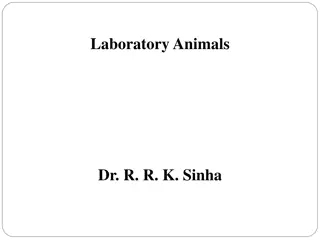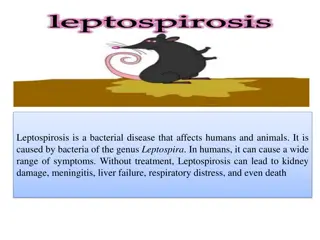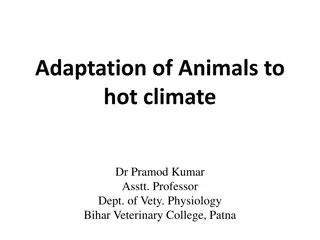Understanding Thermoregulation in Animals and Humans
Thermoregulation is the process of regulating body temperature in organisms. It can be seen in two types of animals - ectothermic and endothermic. Ectothermic animals rely on external energy sources to maintain body temperature, while endothermic animals use internal metabolic energy. The skin plays a crucial role in temperature regulation. In humans, heat generation is facilitated through cellular respiration and hormone secretion, while heat loss occurs through radiation, convection, conduction, and evaporation. The skin, with its epidermis and dermis layers, acts as a key thermoregulator.
Download Presentation

Please find below an Image/Link to download the presentation.
The content on the website is provided AS IS for your information and personal use only. It may not be sold, licensed, or shared on other websites without obtaining consent from the author. Download presentation by click this link. If you encounter any issues during the download, it is possible that the publisher has removed the file from their server.
E N D
Presentation Transcript
Thermoregulation Thermoregulation is the regulation of the body temperature of a organisms Two types of thermoregulation in animals can be seen Ectothermic animals Endothermic animals
Ectothermic and endothermic animals Ectothermic : organisms use energy from the external environment to maintain there body temperature. Examples are invertebrates, fish frogs and reptiles. The metabolic and behaviour activity depends on external temperature changes Endothermic : Organisms use internal metabolic energy to maintain their body temperature. In endothermic animals the skin is important for regulating temperature. It is the larges organ, covering the entire outer surface of the body
Heat generation in the human body Cellular respiration Secretion of thyroxin and adrenalin that increases the metabolic rate Behavioural patterns- lie in the sun, drink warm liquids
Heat loss in the human body Radiation Convection Conduction Evaporation
Human skin as Thermoregulator Because the skin forms the outer boundary between the internal and the external environment, it plays a important role in the regulation of body temperature
Structure of the skin The skin consists of two main layers, namely Epidermis Dermis
The epidermis consists out of the following The cornified layer: Made up of dead, flat, scale-like epidermal cells in which a protein, keratin, is deposited. These cells are constantly worn off and are replaced from beneath in order to protect the underlying layers The granular layer: made up of granulated cells. Free nerve endings extend into this layer The inner most malpighian layer: Made up of cubiodal cells that undergo constant cell division. It also contains pigment granules called melanin, which gives the skin its colour. Melanin protects the underlying tissues from harmful ultraviolet rays of the sun
The dermis The dermis is much thicker than the epidermis and is made up of areolar connective tissue. It contains: Blood and lymph vessels Nerve and sense receptors Hair follicles( with hairs), sebaceous glands and erector muscles Sweat glands and adipose tissue Erector muscles and a dense network of blood vessels A layer f subcutaneous fat below the dermis
The skin and thermoregulation Parts of the skin which play a role in thermoregulation are Blood vessels Sweat glands Nerve fibres and sensory receptors Erector muscles and hairs Fatty layers
Regulation of body temp on a warm day Rise in environmental temperature is detected by the ruffini corpuscles in the skin and converted into nerve impulses that stimulate the heat regulating centre in the hypothalamus Hypothalamus sends nerve impulses to the involuntary muscle layer in the skin capillaries The circular muscles relax and the capillaries widen, which is known as vasodilation More blood now flows to the skin surface, resulting in more heat loss through radiation, convection or conduction Due to vasodilation more blood flows to the sweat glands resulting in increased sweat secretion
Regulation of body temp on a warm day More sweat evaporates from skin surface and more heat loss occurs Erector muscles are not stimulated and hair lies flat If heat loss through skin is not sufficient, the body reduces heat production Decrease heat production is brought about the following ways Muscle tone of the voluntary muscles decreases and the person becomes less active Decreased thyroxin production results in a lower metabolic rate
Regulation of body temp on a cold day Drop in temperature is detected by the krausian corpuscles in the skin and converted into nerve impulses that stimulate the heat-regulation centre in the hypothalamus The hypothalamus sends nerve impulses to the involuntary muscle layer in the skin s capillaries The circular muscles contract and the capillaries become narrower, which is known as vasoconstriction Blood is redirected to blood vessels in the deeper skin layers Less blood now flows to the skin surface with the result that less heat is lost through radiation. Convection or conduction
Regulation of body temp on a cold day Due to vasoconstriction less blood flows to sweat glands, resulting in reduced sweat secretion Less sweat evaporates from the skin surface and therefore heat loss is reduced Hypothalamus transmit nerve impulses to the erector muscles and causes the hair follicles to be pulled upright Hair stand on end , trapping more air in between them. Air poor conductor of heat and therefore less heat is lost If environmental temp drops even lower, the restriction of heat loss through the skin is no longer sufficient and becomes necessary for the body to increase its heat production Increased heat production is brought about the following ways Muscle tone of the voluntary muscles is increased, causing a person to shiver Increased thyroxin production raises the metabolic rate
Hyperthermia It is an increased body temperature as a result of the body inability to control its temperature Condition occurs when the body produces or absorbs more heat than it loses Most common form of hyperthermia is heat/sun stroke, which is caused by prolonged exposure to extreme heat conditions and/or humidity Mechanisms for thermoregulation in the body are overwhelmed and can no longer function effectively. Causes the body temp to rise uncontrolled Body temp above 40 C is life threatening Symptoms Body temp above 40C Headache Dizziness Increased heart rate Confusion/coma
Hypothermia It is a condition were the core body temp drops lower than the temperature required for normal metabolic and bodily functions Condition occurs when more heat is lost than produced or absorbed It is caused by prolonged exposure to extremely cold conditions The internal mechanisms in the body cannot replace heat that is lost and this leads to a drop in core temp Symptoms Core temp below 35C Shivering Gradual loss of brain functions























